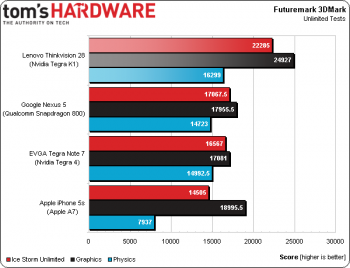
Early NVIDIA Tegra K1 benchmarks show promising results
NVIDIA announced a doozy of a processor at CES last week, with the 192-core NVIDIA Tegra K1 stealing the show. While all the tech demos and claims say this thing is a beast, some folks were still wondering just how much more powerful this processor is up against the likes of Qualcomm’s Snapdragon 800 and Apple’s A7 chipset. Thankfully, Tom’s Hardware was able to deliver that answer.
Early benchmark tests from the Tegra K1-equipped Lenovo ThinkVision 28, a 28-inch 4K monitor that runs Android, handily outclasses the competition in many different areas. In standard 3DMark tests for GPU graphics, CPU physics and the Ice Storm Unlimited demo at 720p across the board (meaning there’s no need to take resolution differences into account), the Tegra K1 runs at least a full lap around Apple’s A7, Qualcomm’s Snapdragon 800 and NVIDIA’s own Tegra 4.
While the K1 didn’t have a huge lead in physics calculations, graphics performance easily surpassed the aforementioned processors by around 25%. It’s an interesting result considering the Tegra K1’s clock speed is artificially limited (meaning even faster configurations could bring more impressive results down the line).
Of course, comparing the Tegra K1 to Qualcomm’s older Snapdragon 800 isn’t a terribly fair comparison. We’d be more interested in seeing how it stacks up to the Snapdragon 805, though no devices with that SoC are available for testing at this time.
Benchmarks in Antutu show some very interesting results, with Tegra 4 beating out the Tegra K1 by a pretty decent margin. It’s worth noting that the Tegra K1 scored much higher than Tegra 4 in the user interface composition tests, though the K1 lacked in GPU performance. Everything else was pretty much neck-and-neck. It’s tough to say why these results turned out like they did. It could be due to the fact that Antutu doesn’t yet support the Tegra K1, but as it stands the Tegra 4 beats it in terms of overall score.
It’s worth noting that benchmarks don’t always tell the full story, as real-world performance can also be much different than what the numbers on paper say. We’ll have to wait for more devices and more testing to see where, exactly, the K1 stands, but things are definitely looking bright for NVIDIA’s latest silicon project.